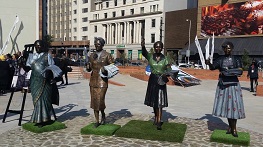Democracy
Women's monument unveiled in Tshwane
The four women led a peaceful protest march to the Union Buildings in 1956, with thousands of women from all parts of the country. The women delivered a petition to the then Prime Minister, JG Strijdom, against carrying a pass book, referred to as a dom pass in Afrikaans, meaning "dumb pass". They also marched against the degradation of African women. This Women's Day marked the 60th anniversary of the march. The monument also includes a leadership development and training centre, and dedicated walls for murals, artworks and artefacts that tell the stories of women’s struggles throughout the South Africa’s history. Susan Shabangu, the Minister of Women in the Presidency, said the event was an emotional reflection on what women have done to take the country from where it was to where it is today. "Women once more are gathered here to witness the opening of the living monument, where people can see the contribution of women across colour lines," the minister said in her presentation. Shabangu asked women, particularly young women, to visit the monument in order to reflect and inform their destiny, adding that "the women of the 1956 march played their role and today we have a Constitution which includes what women fought for". She said it is up to the young South African women of today to protect the Constitution and ensure human rights, especially women’s rights, are not violated. Deputy President Cyril Ramaphosa, African Union Commission chairperson Nkosazana Dlamini-Zuma and the last surviving march leader De Bruyn, were among those who attended the unveiling and toured the monument.2. The Women's Living Heritage Monument at Lillian Ngoyi Square in PTA #WomensDay pic.twitter.com/CG0TDX8HEQ
— #ThankYouLimpopo (@ANCLimpopo) August 9, 2016
De Bruyn told EWN News that the monument and recognition of the struggle of women during apartheid gave her great joy, particularly seeing how far women have come in advancing their rights since 1956. "Today when I see what they've achieved, they've achieved a lot. They can choose their own professions, they can choose anything they want to do, and I often say to them that it's no longer a case of the sky being the limit. But you can go beyond the sky because you can even become an astronaut."Sophie De Bruyn standing next to her statue unveiled at Lillian Ngoyi Square #TellHerStory #WomensDay pic.twitter.com/xpYIflHZK4
— SA Gov News (@SAgovnews) August 9, 2016
Also in attendance were a number of women who were part of the original 1956 march. Mita Motlolometsi marched 60 years ago and had come to witness the unveiling of the monument. She said the day was an emotional one for her because she had witnessed history unfold around her over the last six decades, particularly since 1994. She felt proud that she had been a small part of bringing change to the country. However, while commending the interventions made by democracy to empower black people, Motlolometsi said that women and, especially elderly women, were not fully liberated yet. Motlolometsi hopes there will be more efforts made by the country to unite, respect and liberate the nation's women. Source: South African Government News Agency Southafrica.info reporter Would you like to use this article in your publication or on your website? See: Using SouthAfrica.info material#WomensDay2016 These women were among the thousands who marched on August 9 1956. DB. pic.twitter.com/4XLKns6dUl
— EWN Reporter (@ewnreporter) August 9, 2016
 Four statues of the heroic stalwarts form part of the Living Heritage Monument, Lillian Ngoyi, Sophia Williams de Bruyn, Helen Joseph and Rahima Moosa.(Image: SA News)
Four statues of the heroic stalwarts form part of the Living Heritage Monument, Lillian Ngoyi, Sophia Williams de Bruyn, Helen Joseph and Rahima Moosa.(Image: SA News)
Related links
Related articles
National flag
Whatever shape our flag takes, it's instantly recognised by South Africans everywhere.
National symbols
What's that image on your R5 coin? What does !ke e: /xarra //ke mean? (Whose language is that?) ...





